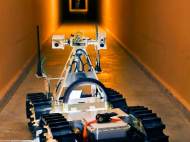Sandia Gemini-Scout Mine Rescue Robot could aid in future miner rescues
 When a mining accident occurs, potentially deadly conditions such as poisonous gases, flooded tunnels, explosive vapors, unstable walls and roofs, and unknown obstacles between the surface and trapped workers can significantly slow the rescue efforts. Engineers at Sandia National Laboratories developed the Gemini-Scout Mine Rescue Robot in order to collects information about potential dangers and aid trapped workers.
When a mining accident occurs, potentially deadly conditions such as poisonous gases, flooded tunnels, explosive vapors, unstable walls and roofs, and unknown obstacles between the surface and trapped workers can significantly slow the rescue efforts. Engineers at Sandia National Laboratories developed the Gemini-Scout Mine Rescue Robot in order to collects information about potential dangers and aid trapped workers.
Gemini-Scout Mine Rescue Robot is less than 61cm (4 feet) long and 30.5cm (2 feet) tall, and it is nimble enough to navigate around tight corners and over safety. Sandia engineers had to build something intuitive for new operators who need to learn the system quickly, so they used an Xbox 360 game controller to direct the robot.
“We have designed this robot to go in ahead of its handlers, to assess the situation and potential hazards and allow operations to move more quickly”, said Jon Salton, Sandia engineer and project manager. “The robot is guided by remote control and is equipped with gas sensors, a thermal camera to locate survivors and another pan-and-tilt camera mounted several feet up to see the obstacles we’re facing.”
Aside providing important information to the rescuers, the robotic scout can haul food, air packs and medicine to those trapped underground. It is equipped with two-way radios and it can be altered to drag survivors to safety. Designers built the Gemini-Scout to negotiate nearly every known mine hazard. Methane and other gases can ignite if exposed to sparks, so the electronics are housed in casings designed to withstand an explosion.
“Such measures would prevent a spark from causing further destruction. While it might harm the robot, it wouldn’t create another dangerous situation for the miners or rescuers”, said Salton.
To ensure functionality in flooded tunnels, Gemini-Scout’s controls and equipment needed to be waterproof. It’s able to navigate through 45cm (18 inches) of water, crawl over boulders and rubble piles, and move in ahead of rescuers to evaluate potentially hazardous environments and help in rescue operations planning.
“When we were designing a robot that could provide this level of assistance, we had to be aware of the pressures and gases that are often found in that environment”, said Clint Hobart, Sandia engineer who was responsible for the mechanical design and system integration. “So we had to make sure the strength of materials matched what our goals were, and we had to keep everything lightweight enough so it could navigate easily.”
The team is in the final stages of licensing Gemini-Scout to a commercial robotics company, but for now, the Mine Safety and Health Administration will be their primary customer. If all goes well, the Gemini-Scout could be ready to head underground by the end of next year, and they hope it will be used along other first responders, such as police, firefighters and medical personnel.









The robot is meant to work underground and it’s not equipped with tools for digging and some sonic sensor? Preposterous.